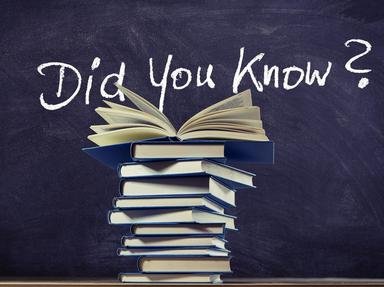Quiz Answer Key and Fun Facts
1. The Pastry War was fought between France and which country?
2. The video game "Legend of Zelda" is mainly set in which fictional land?
3. Who was the first of the seven people who attempted to assassinate Queen Victoria of England?
4. Which element of the Periodic Table did Karl Ernst Claus discover in 1844?
5. In Greek mythology, Hermes stole cattle from his fellow god, Apollo. Who did Hermes turn to stone for revealing that he had done this?
6. Between 1894-95, who became the first woman to ever bicycle around the world?
7. "Small Sacrifices" is a 1989 film based on the real events regarding murderer Diane Downs. Who played her?
8. Between July 13-14, 1977, which of these events afflicted New York City?
9. Gyūtan is a Japanese dish made from which of these?
10. Sunderland Association Football Club is an English professional football club with their home ground being the Stadium of Light. Where was their home ground before this?
11. Idi Amin became President of Uganda in 1971. Who did he overthrow in a coup to achieve this?
12. American rock band, Creedence Clearwater Revival, released three albums in the 1969. Which of these was the first they released in that year?
13. Megawati Sukarnoputri was the first female president of which country?
14. Which of these was the first novel of science fiction author Michael Crichton under his own name?
15. Which of these is the chief deity in the Yoruba Religion?
16. Snickers is a chocolate bar produced by American company, Mars Incorporated. What brand name was Snickers sold as in the U.K until 1990?
17. Which of these is a Polish poppy seed cake?
18. What features on the obverse on most coins of Bahrain?
19. Ismail I was the founder of which dynasty?
20. Which bird features on the flag of Uganda?
Source: Author
LuH77
This quiz was reviewed by FunTrivia editor
agony before going online.
Any errors found in FunTrivia content are routinely corrected through our feedback system.

